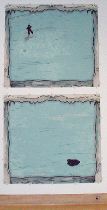 My mantra for years has been small is beautiful. I say it to all the young artists I meet who tell me, apologetically, while standing in front of their reasonable-sized art, that they’re working on something bigger… or that they want to work bigger.
My mantra for years has been small is beautiful. I say it to all the young artists I meet who tell me, apologetically, while standing in front of their reasonable-sized art, that they’re working on something bigger… or that they want to work bigger.
Small, I tell them. Small is the way, not bigger.
But sometimes big is the way after all —when there is a reason …when the scale makes sense. Like with former Philadelphia artist Randy Bolton‘s huge new banner prints in his solo exhibit “Twice Told Tales” at Cranbrook Museum of Art in Bloomfield Hills, MI. (top image is a diptych “Thin Ice.”)
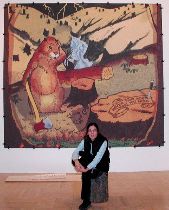
Bolton, whose digital prints I’ve admired for years, has ratcheted his work up and out of the realm of intimate viewing and into the realm of public art. (Read my recent post for more on Bolton—and Cranbrook)
The new works, printed on fabric by an industrial printer (and hemmed by the artist who learned how to sew on a machine to do so) have messages on them in words and images. And while the banners have the authority of public service announcements (“Never take more than you need” is one maxim), their touch is light and not preachy. This is not your know-it-all big brother authority figure counseling “just say no.”
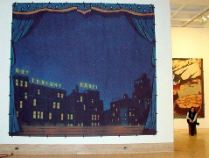
Bolton’s announcements are witty and wry — and their beauty and old-fashioned charm are seductive. And their advice, at bottom, is “think, study, consider the consequences and don’t be hoodwinked by con artists.” (shown above left is “Never take more than you need.” Bolton’s wife, artist Kathleen McShane sits on the log and gives you an idea of the scale of the piece. Right is “Not Tonight, Honey.”)

Bolton’s push to big makes sense in an artist who has always spoken in haiku-like messages about big issues. Even when he works small, Bolton’s message was always big. He’s ever one to debunk the prevailing wisdom and show it as nonsense. And he’s ever about the importance of personal responsibility in life. “Don’t follow the leader because he’s going over the edge,” is a recurring theme as is “Who says the wolf is big and bad?” (image left is a triptych “Yours, Mine, Ours.” Bolton carved images from the work onto the small log stools that sit in front of the work.)
The artist, who is something of a bibliophile, finds his source material is children’s books—the antique variety and not the great literary works of Beatrix Potter or Lewis Carroll. Bolton mines the mass-produced school textbooks that paraded Dick and Jane before generations of children in lessons that taught reading with a subtext of obedience to authority.
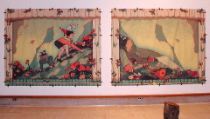
Any artist with a rebel’s soul would find that source material plum pickings. Bolton has mined it for years collaging imagery from this book and that and packaging it anew with punchlines so different from the source material they might have been written on Mars. (image right is “Rise and Fall.”)
I saw these prints first in September when I visited Cranbrook where Bolton is head of the Print Media department. He laid them out on the floor in his house to show me and they consumed the big room—eleven ft. high, and almost as wide (or wider in the case of some diptych and triptych works.) The scale was such a radical departure from past works I’d seen at Schmidt-Dean Gallery, his Philadelphia dealer, that it was exciting. Of course these works were made for a museum exhibition and works in a museum can well afford to be big.
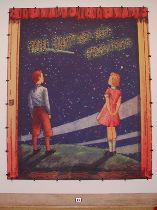
But there’s big and there’s big. These works have an urgency to them that’s beyond museum. I suppose you could consider them wartime works. They were not made in a vacuum of artist sitting alone in a garret dreaming. They respond to the world at large and take a stand against the rampant follower-ism abroad in the land. That’s a bold message and a public message that needs a home where the many can experience it and not just the few. (image is “You can’t get here from there.”)
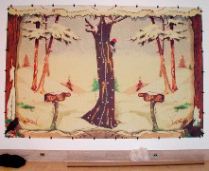
We’re living in a time when art’s messages are small and intimate. But if there’s any medium with a potential for making big messages and big statements, it’s printmaking whose history includes poster making and rabble rousing to wake the sleeping masses for some action or other.
When I think of contemporary printmakers with big messages, I think of Jenny Holzer who, like Bolton, is a cautionary maxim writer. And of course printmakers past, like Honore Daumier and Goya, were big voices in their days making public art about politics and life.
Printmakers like Holzer and Bolton have found ways to dust off and return printmaking to its roots in public messaging. I wish more printmakers would follow this path and fill the galleries, museums and walls of the cities with art that engages the public in discourse about our world. We sorely need it. (bottom image is “Same old, same old.” All the photos in this post were taken by Bolton while he was installing the show. )









